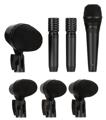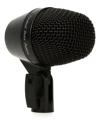
Hello Sweetwater Fans!
My name is Casey Cooper, and I run a YouTube channel based around my life as a drummer aimed at inspiring, educating, and entertaining drummers, people, and musicians all around the world. I absolutely love drumming and always dreamed of playing drums for a living, so in this new media generation, I’ve used the power of the Internet and home recording to chase my dreams. I have been absolutely blown away, humbled, and blessed to see my YouTube channel become the most watched and subscribed to channel in the world for drumming, with over 300 million views and over 1.5 million subscribers. Those numbers certainly don’t make me any more important or better than any other drummer out there, but hopefully they show you the power of the Internet, and they get you pumped to take on the world of YouTube and social media for your own career!
Before we get into my recording process, it’s important to understand that all the time you’ve spent practicing and building your skills as a musician doesn’t get you where you want to go if people never get to see or hear those skills. YouTube is not just a place to build a fan base or get “famous,” but it’s also a place to host videos and content that can become a video resume for potential band auditions/studio work/gigs, etc. With any potential client or opportunity that I have, I can quickly point out a video that either showcases me fulfilling a similar gig or showcases my technical skills needed to fit the gig in question. It also doesn’t hurt that many of those same videos are the ones that have connected me with millions of drummers, musicians, and people all over the world.
Keep It Simple — at First
YouTube videos and content creation can be a daunting place filled with expensive gear and high-dollar studio trips. Some videos you see on YouTube will have multiple cameramen, thousands of dollars worth of cameras, and even more in sound and studio equipment (and I have done my share of higher-production videos on occasion), but your content doesn’t have to be a high-dollar shoot. Almost everything that I have created in my five-plus years and almost 1,000 video catalog on YouTube has been created using the same, very affordable home recording setup that I used when I got started. My most popular video of all time, with over 10 million views, was recorded with a single camera. Many of my other most popular videos feature only one camera, or even sometimes only one room mic.
Create Quality Content
The key to a successful YouTube video is not in the amount or cost of the cameras or microphones, but in the quality of the content produced. One camera angle that catches everything important is far more engaging than five moving cameras that only showcase small pieces of the full picture. One low-cost recording setup or a single room mic that clearly captures the sound and parts you are playing is oftentimes just as successful as recording your content in a world-class studio. That’s because the content is often consumed on mobile phones and laptops where the extra 10%–20% of improvement in sound quality and consistency of high-dollar studios is lost in the cheap sound produced by those low-quality speakers. I’m not saying that a high-dollar recording setup is pointless, because it will be awesome to have and can only help, but I want you to remember that YouTube content creation can be accessible at any budget level and is not as scary or daunting as it seems. If you have an iPhone and a good room mic, with some practice you can produce successful content.
Get the Gear
Over the years, I’ve had a lot of success with varying setups from an iPhone all the way to my almost finished home studio. However, for the last five years, I’ve been using the same Shure PGA mic bundle (2 Condensers – PGA81, 3 Tom/Snare mics – PGA56 and a Kick Mic – PGA52). While it’s not the cheapest drum mic pack out there, it is super rugged and gives me consistently great sound. I added a Shure SM57 for the snare, which gives me a great-sounding, affordable mic setup for a 5-piece kit. Many times I’ve used that setup to mic a kit with more toms by mounting the PGA56 microphones in between two toms and covering them both with a single mic.
In one of my latest videos, I use a 4-mic setup (two overheads, a kick, and a snare) with a Focusrite Scarlett 18i8 to show a low-budget recording setup that you can easily use at home. Of course, the same old adage applies: garbage in, garbage out. If your kit or instrument sounds good before it hits the mics, it’s really easy to get a good-sounding recording whether or not you’re an expert on mic placement.
Keep It Real
One thing to remember is that no matter how great your recording sounds, you won’t please everyone. I’ve had videos that received praise as the “best snare sound I’ve ever heard,” and the same video has comments that say, “I hate that snare sound.” There are many different ways of approaching a mix, but I attack all of my content creation with a “live” mentality. My videos are almost always one take straight through so it feels more like a live performance, and the same thing goes for my audio. I do very minimal post production on the audio files so that the audio sounds live and is cohesive with the video. A little bit of compression and reverb in a stereo mix can go a long way to creating a mix that is clear and understandable, but also live and real. An audio track that sounds real makes your video and your playing much more believable to the audience than a track that is overdubbed or sampled and super-produced.
Look Your Best
Your great audio quality loses almost all of its effectiveness if it is paired with a bad-quality video source. It’s 2017, and almost every phone out there can record HD footage at the very least. I personally use GoPro cameras for almost every single one of my videos. They look great, and the wide-angle lens captures the whole kit and all the parts I’m playing even in small rooms and tight video shooting situations, not to mention they are very budget-friendly and easy to travel and gig with compared with DSLR (Digital Single Lens Reflex) cameras.
Get in Sync
Now once you’ve recorded your video and audio, one of the most difficult parts of producing content is lining up the audio and video correctly. I’m a Mac guy, so I use Logic Pro and Final Cut Pro, but I’ll share a trick that can be applied to just about any software. Once I drag the audio and video into FCP, I use the arrow keys to move the video playback to one frame before my stick hits the first big snare hit, and I cut the file there. I then go to the same snare hit within my audio track and move the audio playback to one frame before I hear the snare hit and cut the file and line it up with the cut video file. And 99% of the time, this works quickly and efficiently.
When editing my videos, I almost always use longer shots before changing camera angles, and I typically try to use the angle that best showcases the parts I’m playing at that particular spot in the song. If I have repeat parts, I’ll often switch to a different angle to show that part from a different perspective. The longer camera shots allow the audience to more effectively watch and learn what you’re playing as opposed to quick changes, which make it hard to focus and consume.
Refine Your Strategy
Here are a few different concepts regarding the content that you are creating that can really make a huge impact on how “successful” your content is on YouTube and social media.
- You need to be first, or you need to be unique. It doesn’t matter how great your audio sounds if you’re the 654th person to cover a song and you do it just like everyone else. You have to find what makes you and your playing special and focus on that. There needs to be something about the way you play and create content that makes you memorable. It doesn’t have to be just the notes you play or the way you play them. It can be the way you film yourself, the look of the videos, or the lighting. It’s even more powerful if you can be the first person to create a really great video for a new song. Your video will appear high on the search rankings, and the people searching for covers of that new song will likely find your video at the top of the results.
- Do it for the right reasons. If you’re doing this work because you love it and you want to provide awesome, entertaining content for people all over the world, then you’ll have a lot more fun and work harder than if you upload a video and only care about how many views or likes it gets. It takes a while to get established on YouTube, but it’s a lot less stressful and frustrating if you’re enjoying the ride.
- Quantity is as important as quality. The more you upload, the better YouTube’s search algorithm works for you, and the more chances there are for someone to find you. If you can upload a great-looking and sounding video every few days, you’ll be amazed at how quickly you’ll get traction on YouTube compared with uploading one great video every month or two.
In Closing
There is so much more to creating great content for YouTube and social media, but hopefully now you have a better understanding of how incredibly beneficial the Internet can be for musicians at all levels. Thanks for taking the time to check this out, and I hope you have an absolute blast creating some of your own videos and content!








